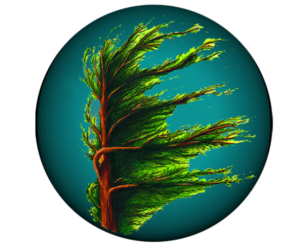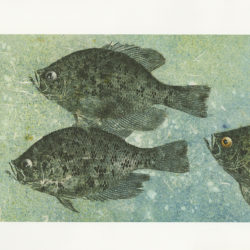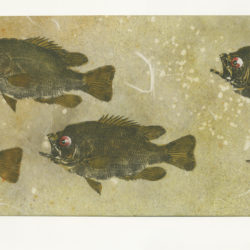Description

Pleasant Bay Striped Bass 1 is a Giclee’ reproduction of a Chokusetsu-ho, or the direct style, Gyotaku print of a Striped Bass, Morone saxatilis . This fish was caught in Pleasant Bay on Cape Cod, Mass. The original was printed with Sumi printing inks on Unyru Dragon Cloud Washi, or Japanese “rice” paper. The colors were added with layers thin washes of artist colors. The “Chop” or red Oriental seal signifies my Japanese artist name, Mutsugoroh.
The hi resolution scan of the original was run at 1600 PPI., the Giclee printed at 350 DPI.
The Subject
The fish that was used to create this image was a Striped bass, Morone saxatilis , a saltwater fish in the true Bass family. Also known as “rockfish” Striped Bass is a popular saltwater fish and held in high regard by sportsman. It is also excellent table fare.
What is Gyotaku??
Gyotaku is a Japanese method of printmaking that traditionally utilizes fish, sea creatures or similar subjects as printing “plates” in its process. The literal translation of the word is “fish stone rubbing” and is believed to get its inspiration from Chinese stone rubbings of calligraphy, which gave rise to printing.
Gyotaku, or Japanese fish printing, was originally used to record and commemorate a fisherman’s catch.
Eventually, it evolved into an art form, with three different approaches. Chokusetsu-ho, or the direct style, is the most similar to the original methodology. The fish is cleaned, prepped, supported, and then inked. At this point, dampened Washi (“rice” paper ) is applied to the fish, and an image is created by careful hand rubbing.
Often, direct prints are left in the Black and white state they are printed, with the eyes painted in afterwards in grayscale.
Finished works can be mounted on scrolls, wet mounted to canvas, to background washi paper and matted and framed. Frequently, the piece includes a red oriental seal, or “chop” and or some calligraphy indicating the artist’s name and information, or important subject matter.
What is a Giclee’ reproduction? –
Derived from the French, the word giclee’ is generally perceived to mean “sprayed ink”. In 1985, a large format color inkjet printer was introduced by Iris Graphics, used for pre-press proofing and for final output digital printing for the fine art reproduction market. The mechanics of this system, using continuous flow ink systems and micro ink head jets to spray the ink produced a continuous tone, dot free output. This represented a departure from the previous standard high quality four color photolithograph reproductions that resulted in microscopically definable rosette dot patterns in the finished piece. This was a visually amazing advance that brought reproductions to a much closer point of representation of the original artwork.
Eventually, Iris printers were superseded by Epson and other large format printers who addressed concerns about handling heavy paper stock and ink longevity. The word “Giclee” was coined to replace earlier references to Iris prints.
True Giclee’ reproductions hold to higher standards possible today, including use of a higher range of ink color divisions, high resolution digital source files and output printing resolution, heavyweight archival quality paper substrate, and use of pigmented inks with improved longevity properties.
The Print – Your Giclee reproduction print was made with some of the best quality materials and techniques available to insure long lived enjoyment of your image. This Reproduction was printed on Epson brand Ultrasmooth Fine Art Paper, 425 g/m3 in weight. The paper is not only acid, lignin, and chlorine-free, it is also pH-buffered with calcium carbonate for long-term archival stability. The inks used on your reproduction are Epson brand Ultrachrome K3 inks, with expected color longevity in excess of 50 years. The primary digital scans of the original art work were made at 1200 PPI or higher. The prints are created at a DPI output of 350 or better, to ensure good continuous tone results in the final print.





